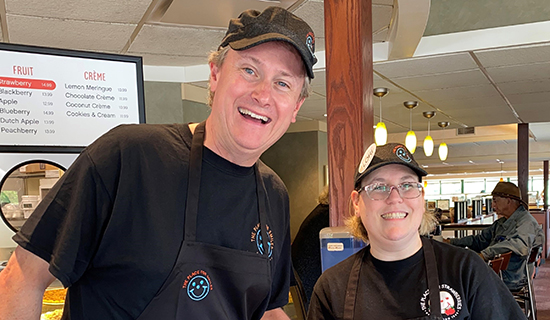When Jeff Broadhurst joined his family’s business in 1996, the company operated about 75 Eat’n Park family restaurants throughout the region. Recognizing a great opportunity to diversify beyond a single restaurant chain into contract dining, Broadhurst left his job at an investment firm in Chicago to help his family launch Parkhurst Dining, which now makes up 60 percent of their overall business.
Since then, Eat’n Park Hospitality Group has continued to diversify by innovating fresh dining concepts and services to meet the evolving needs of hungry guests. Now as president and CEO, as well as president of both the restaurant and contract dining divisions, Broadhurst leads the company toward new opportunities — operating a portfolio that spans 15 states and includes:
- 57 Eat’n Park restaurants
- 10 fast-casual burger and salad spots known as Hello Bistro
- Two outdoor dining destination restaurants called The Porch
- SmileyCookie.com, an online store selling the brand’s signature treat
- Parkhurst Dining, which provides contract dining and catering services to more than 100 corporations and higher education institutions
Through it all, Broadhurst says the key to the company’s growth and success boils down to a simple purpose of making people smile.
“That’s one of the reasons why I came back to the company,” says Broadhurst, who previously worked at the family restaurant chain during high school. “Why wouldn’t you want to work for a company where that’s all we try to do every day, creating more smiles than we did yesterday?”
Guided by that purpose, Broadhurst leads the business alongside his brothers, Brooks Broadhurst, vice president of food systems transformation, and Mark Broadhurst, COO of Parkhurst Dining. By prioritizing innovation to remain relevant while taking care of their people, the Eat’n Park leadership team stays ahead of changing trends while gaining dedicated employees and loyal customers.
Innovating to stay relevant
As one of the company’s core values, innovation has been key to Eat’n Park’s growth and success since Jeff’s father became treasurer in the ’70s and bought the company in the early ’80s. Jim Broadhurst, who retired in 2008 and remains involved as chairman of the board, introduced concepts like the now-famous Smiley Cookie and the chain’s ever-popular salad bar.
Diversifying into additional dining concepts has expanded the opportunities for innovation across the company.
“What we learn at the restaurants, we can leverage at Parkhurst, and vice versa,” Broadhurst says. “That’s one of the reasons why we continue to be successful, because we’ve got this shared innovation between brands and divisions.”
For example, after seeing the success of Hello Bistro’s fast-casual approach to burgers and salads, the company copied the concept in the Parkhurst Dining side of the business and introduced “Hello Bistro Express” salad bars at some campuses.
This willingness to try new ideas is key to staying relevant as dining preferences evolve. For example, when takeout volume was flatlining across the restaurant industry in the late 2000s, Eat’n Park leaders looked ahead to anticipate customers’ needs. They came up with the idea to install pickup windows, which “may not sound big in an industry with drive-thru windows everywhere,” Broadhurst says, “but no one had takeout windows in a full-service restaurant.”
Now, 49 of Eat’n Park’s 57 locations have pickup windows. This turned out to be immeasurably valuable when the pandemic abruptly halted dining room service, as pickup orders increased by 80 percent to comprise 23 percent of the business.
Ordering options continue to evolve, more recently with the launch of new apps to streamline the ordering process. Hello Bistro rolled out its new app in March as a test run before the new Eat’n Park app was released in May.
“It’s not that the apps were broken before,” Broadhurst says, “but [every update] is an opportunity to meet the guests where they want to be met in the overall process.”
Renovating restaurants
In the midst of the pandemic in early 2021, when many restaurants were shuttered, Eat’n Park opened a brand-new location in Butler, Pa. While it was a risky move to make during a downturn, Broadhurst says it sent an important message.
“It’s a way to show the community that we’re relevant, so when they’re ready to come back and dine in, we’d be there ready for them,” he says. “We’ve spent two years now reminding them that we’re a safe, friendly place to dine out again.”
Eat’n Park is continuing to refresh its look with ongoing renovations. By the end of 2024, the brand plans to renovate 28 locations, plus three other “massive remodels” involving buildings that will be completely gutted and redone. On average, Eat’n Park spends about $5 million every year on renovations. After skipping updates in 2020, “it’s time to catch up,” Broadhurst says.
The Parkhurst side of the business, likewise, freshens up its units every year. While these aren’t necessarily big remodels, the company regularly collaborates with chefs and clients to swap out food stations and revamp menus, “just so we never get stale,” Broadhurst says.
Sourcing locally
In the early 2000s, chefs started asking why their produce and other ingredients were arriving on trucks from out-of-state, when local farmers were offering fresher options closer to campus.
The problem was that “none of those farms had a way to deliver to our units,” Broadhurst explains. To solve this dilemma, Brooks and the company’s director of sourcing and sustainability, Jamie Moore, led the development of a FarmSource program to start partnering with local farms in 2002.
Now, 10 to 20 percent of ingredients are sourced locally, which the company defines as a 100-mile radius from each location. During the local growing season, this swells to 25 percent, providing more fresh ingredients for guests.
“The quality is better because the products haven’t been sitting in a truck,” Broadhurst says. “It’s really fresh; in some cases, it was just picked.”
More importantly, this program helps support the local communities where the company operates, which is another pillar of its purpose.
“We care about the communities in which we live, work, and play,” Broadhurst says. “We’re all about giving back.”
Taking care of people
Another core value of the company is its commitment to caring for people — including team members and guests in addition to the surrounding community.
“In our business, we’re only as good as our 9,000-plus team members,” Broadhurst says. “Yeah, we sell food, but if we didn’t have great chefs making it, the food would be lousy. [Success] starts with our team.”
The first step to taking care of the team is making sure that each person understands their role in the company’s purpose, whether they’re a greeter or a sous chef. That alignment starts with the interviewing process by identifying which candidates are team players with positive attitudes.
“If people are friendly and can smile, we can teach them the basics of this industry,” Broadhurst says. “But it’s hard to teach someone to be friendly if they’re not smiling.”
Onboarding is another important step in helping employees understand how each position relates to the broader purpose. This continues through ongoing training, all the way through to leadership development.
“We talk a lot about treating people how they want to be treated, which is something my mother taught me and always reminded me about,” Broadhurst says.
That commitment ranges from simple things, like offering flexible schedules, to much larger investments.
In 2020, for example, the company established a Team Member Assistance Fund to support employees in need. Last year, the program provided grants to nearly 40 team members. When some employees were furloughed during the pandemic, the company covered all their insurance copays and provided basic necessities to help them get by. This commitment to investing in employees reaps long-term loyalty, Broadhurst says, resulting in low turnover — 13 percent below the hospitality industry average last year.
“It really does make a difference when you walk in and see a familiar face,” says Broadhurst, who visits his restaurants often. “Every day when you walk in, we want you to know the people who are serving you, because it’s the same people who served you yesterday.”
The company rewards tenure through its Half Century Club, which has more than 700 members who have worked at the company for at least 25 consecutive years. Once inducted, employees become members for life, and they celebrate with a Quarter Century Dinner party every May to honor everyone who has hit the 25-year milestone.
Giving back to the community
The company’s commitment to caring extends beyond its restaurants into the rest of the community. Every year, the company donates at least 5 percent of its pre-tax earnings to local charities and more than 200,000 Smiley Cookies to nonprofit organizations and events.
Although fundraising and volunteering efforts happen throughout the year, the biggest push comes during the holidays when the company holds its six-week Caring for Kids Campaign. The annual fundraiser has collected nearly $12 million for local children’s hospitals since 1979, most of it going toward free care funds to provide medical care to families who can’t afford it. Last year, the employee-driven campaign raised over $300,000.
“It’s really fun to see our team members so excited to give back to the community in their own ways through different auctions, fundraisers and raffles,” Broadhurst says. “It’s a friendly competition.”
Once a year, team members also rally for an organized volunteering event, called A Day of Smiles, when they collectively serve local charities together. Last year, for example, some team members filled backpacks at Best of the Batch Foundation — a nonprofit organization founded by former Pittsburgh Steelers quarterback, Charlie Batch — while others volunteered at the Greater Pittsburgh Community Food Bank and other organizations to support families in the community.
“We’re spreading smiles throughout the community by giving back,” Broadhurst says.
Building a legacy
In June 2024, Eat’n Park Hospitality Group will celebrate its 75th anniversary — a milestone that Broadhurst says is only possible because they’ve taken a generational approach to the company’s long-term growth.
“We’re in a long-term business,” he says. “It’s not about today; it’s about planning for tomorrow. What can we do today to make us stronger and more successful next year and beyond? We don’t have to worry about quarterly earnings like a lot of our competitors that are publicly held. We’re just thinking about the future.”
Last year, the company grew 21 percent, finishing 2022 with $412 million in revenue as the industry continues to rebound from the pandemic. By continuing to innovate new ways to meet customers’ changing needs while staying committed to supporting people inside the organization and throughout the community, the company has its sights set on the next generation of growth.
“We never want to become stagnant or complacent,” Broadhurst says. “We can always be better.” ●
TAKEAWAYS
- Stay true to your company’s purpose and core values.
- Continue innovating to meet customers’ evolving expectations.
- Take care of your people, both inside the organization and throughout the community.



